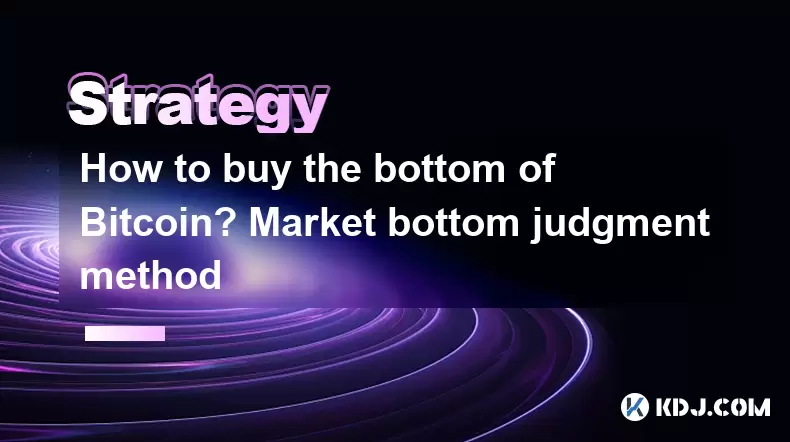-
 bitcoin
bitcoin $124586.364639 USD
0.62% -
 ethereum
ethereum $4670.671710 USD
3.33% -
 xrp
xrp $2.983701 USD
0.18% -
 tether
tether $1.000175 USD
-0.03% -
 bnb
bnb $1209.430642 USD
2.76% -
 solana
solana $231.365861 USD
0.51% -
 usd-coin
usd-coin $0.999665 USD
-0.02% -
 dogecoin
dogecoin $0.264657 USD
4.46% -
 tron
tron $0.346415 USD
1.60% -
 cardano
cardano $0.871586 USD
3.70% -
 chainlink
chainlink $23.451270 USD
7.56% -
 hyperliquid
hyperliquid $46.860071 USD
-2.96% -
 ethena-usde
ethena-usde $1.000120 USD
0.04% -
 sui
sui $3.611279 USD
1.08% -
 stellar
stellar $0.407149 USD
0.96%
How to buy the bottom of Bitcoin? Market bottom judgment method
To buy Bitcoin at its bottom, use technical analysis like moving averages and RSI, monitor market sentiment, and consider fundamental factors like hash rate and transaction volume.
May 13, 2025 at 07:57 am

Buying the bottom of Bitcoin can be an incredibly lucrative strategy if executed correctly. However, it requires a deep understanding of market dynamics and a keen sense of timing. In this article, we will explore various methods to identify the bottom of the Bitcoin market and provide a detailed guide on how to approach buying at these critical points.
Understanding Market Cycles
Bitcoin, like any other financial asset, follows a cyclical pattern. These cycles consist of bull markets, where prices rise, and bear markets, where prices fall. Recognizing these cycles is crucial for identifying potential market bottoms. Historically, Bitcoin has experienced significant bull runs followed by sharp corrections, which often present buying opportunities at the bottom.
To understand these cycles, it's important to study past market behavior. Look at historical data to identify patterns in price movements, trading volumes, and market sentiment. This historical analysis can provide insights into how long bear markets typically last and how deep the price drops can be.
Technical Analysis for Bottom Identification
Technical analysis is a powerful tool for identifying potential market bottoms. This method involves analyzing charts and using various indicators to predict future price movements. Some of the most effective indicators for spotting market bottoms include:
- Moving Averages: The crossover of short-term and long-term moving averages can signal a potential reversal. For instance, when a short-term moving average (e.g., 50-day) crosses above a long-term moving average (e.g., 200-day), it may indicate a bullish trend.
- Relative Strength Index (RSI): The RSI measures the speed and change of price movements. An RSI reading below 30 often indicates that an asset is oversold and may be due for a reversal.
- Bollinger Bands: These bands measure market volatility. When the price touches the lower Bollinger Band, it can be a sign that the market is at a potential bottom.
Combining these indicators can provide a more robust signal for identifying market bottoms. For example, if the RSI is below 30 and the price is touching the lower Bollinger Band, it might be a strong indication that the market is oversold and could soon reverse.
Sentiment Analysis
Market sentiment plays a crucial role in identifying market bottoms. Sentiment analysis involves gauging the overall mood of the market, often through social media, news, and other public sources. During market bottoms, sentiment is typically extremely negative, with widespread fear and panic among investors.
Tools like the Fear and Greed Index can be useful for measuring market sentiment. This index aggregates various data points to provide a single value that indicates whether the market is driven by fear or greed. A low Fear and Greed Index score can signal that the market is at or near a bottom.
Additionally, monitoring social media platforms and forums can provide real-time insights into market sentiment. Look for keywords and phrases that indicate fear or capitulation, such as 'bear market,' 'crash,' or 'I'm selling everything.' These sentiments often peak at market bottoms.
Fundamental Analysis
Fundamental analysis involves evaluating the underlying factors that drive Bitcoin's value. This includes factors such as network growth, adoption rates, and technological developments. During market bottoms, these fundamentals often remain strong despite the price drop, indicating that the sell-off is driven by fear rather than a deterioration in Bitcoin's value proposition.
Key metrics to consider include:- Hash Rate: A stable or increasing hash rate indicates that miners are still committed to the network, suggesting confidence in Bitcoin's future.
- Transaction Volume: High transaction volumes can indicate strong usage and adoption, even during price declines.
- Development Activity: Active development and updates to the Bitcoin protocol can signal ongoing improvement and innovation.
Practical Steps to Buy the Bottom
Buying the bottom of Bitcoin requires careful planning and execution. Here are the practical steps you can take to position yourself to buy at the bottom:
- Set Up Price Alerts: Use cryptocurrency trading platforms or apps to set up price alerts for Bitcoin. This will notify you when the price reaches a level you believe could be the bottom.
- Allocate Funds: Determine how much capital you are willing to invest at the bottom. It's important to have funds readily available so you can act quickly when the opportunity arises.
- Monitor Indicators: Regularly check technical and sentiment indicators to confirm that the market is indeed at a bottom. Use multiple indicators to increase your confidence in the signal.
- Execute Trades: Once you have confirmed that the market is at a bottom, execute your trades quickly. Use limit orders to buy at your desired price to ensure you get the best possible entry point.
Risk Management
Buying the bottom of Bitcoin is not without risk. Even with careful analysis, there is no guarantee that the market will rebound immediately. Therefore, implementing effective risk management strategies is essential.
- Diversify Your Portfolio: Don't put all your funds into Bitcoin at once. Consider diversifying your investments across different assets to mitigate risk.
- Use Stop-Loss Orders: Set stop-loss orders to automatically sell your Bitcoin if the price drops below a certain level. This can help limit your losses if the market continues to decline.
- Invest Gradually: Instead of investing all your funds at once, consider dollar-cost averaging. This involves investing a fixed amount of money at regular intervals, which can reduce the impact of volatility.
Frequently Asked Questions
Q: How long should I hold Bitcoin after buying at the bottom?A: The duration of your investment depends on your investment goals and risk tolerance. Some investors may hold for short-term gains, while others may hold for the long term, believing in Bitcoin's long-term value proposition. Monitor market conditions and adjust your strategy accordingly.
Q: Can I use the same methods to identify the bottom of other cryptocurrencies?A: Yes, many of the methods discussed, such as technical analysis and sentiment analysis, can be applied to other cryptocurrencies. However, each cryptocurrency may have unique characteristics and market dynamics, so it's important to adapt your analysis accordingly.
Q: What are some common mistakes to avoid when trying to buy the bottom of Bitcoin?A: Common mistakes include investing too much capital at once, not using stop-loss orders, and relying on a single indicator for decision-making. Always use a combination of analysis methods and maintain a disciplined approach to risk management.
Q: Is it possible to consistently buy the bottom of Bitcoin?A: Consistently buying the bottom of Bitcoin is extremely challenging, even for experienced traders. Markets can be unpredictable, and bottoms can be difficult to identify in real-time. It's important to approach this strategy with realistic expectations and a well-thought-out plan.
Disclaimer:info@kdj.com
The information provided is not trading advice. kdj.com does not assume any responsibility for any investments made based on the information provided in this article. Cryptocurrencies are highly volatile and it is highly recommended that you invest with caution after thorough research!
If you believe that the content used on this website infringes your copyright, please contact us immediately (info@kdj.com) and we will delete it promptly.
- BlockDAG, DOGE, HYPE Sponsorship: Crypto Trends Shaping 2025
- 2025-10-01 00:25:13
- Deutsche Börse and Circle: A StableCoin Adoption Powerhouse in Europe
- 2025-10-01 00:25:13
- BlockDAG's Presale Buzz: Is It the Crypto to Watch in October 2025?
- 2025-10-01 00:30:13
- Bitcoin, Crypto, and IQ: When Genius Meets Digital Gold?
- 2025-10-01 00:30:13
- Stablecoins, American Innovation, and Wallet Tokens: The Next Frontier
- 2025-10-01 00:35:12
- NBU, Coins, and Crypto in Ukraine: A New Yorker's Take
- 2025-10-01 00:45:14
Related knowledge

Practical parameter settings for a Bitcoin multi-timeframe moving average system
Sep 18,2025 at 10:54pm
Optimizing Timeframe Combinations for Bitcoin Trading1. Selecting appropriate timeframes is crucial when building a multi-timeframe moving average sys...

How can I filter out false breakouts in Dogecoin high-frequency trading?
Sep 22,2025 at 01:00am
Understanding False Breakouts in Dogecoin Trading1. A false breakout occurs when Dogecoin's price appears to move beyond a defined support or resistan...

Techniques for identifying tops and bottoms in the Bitcoin on-chain NVT model
Sep 20,2025 at 07:54pm
Understanding the NVT Model in Bitcoin Analysis1. The Network Value to Transactions (NVT) ratio is often described as the 'P/E ratio' of the cryptocur...

What does the surge in open interest in Bitcoincoin futures mean?
Sep 20,2025 at 11:18pm
Understanding the Surge in Dogecoin Futures Open Interest1. A surge in open interest within Dogecoin futures indicates a growing number of active cont...

How can I use the Ethereum USDT premium to gauge market sentiment?
Sep 18,2025 at 11:55pm
Understanding the Ethereum USDT Premium1. The Ethereum USDT premium refers to the price difference between USDT (Tether) traded on Ethereum-based plat...

What should I do if Ethereum staking yields decline?
Sep 20,2025 at 06:18am
Understanding the Causes Behind Declining Ethereum Staking Yields1. The Ethereum network transitioned to a proof-of-stake consensus mechanism with the...

Practical parameter settings for a Bitcoin multi-timeframe moving average system
Sep 18,2025 at 10:54pm
Optimizing Timeframe Combinations for Bitcoin Trading1. Selecting appropriate timeframes is crucial when building a multi-timeframe moving average sys...

How can I filter out false breakouts in Dogecoin high-frequency trading?
Sep 22,2025 at 01:00am
Understanding False Breakouts in Dogecoin Trading1. A false breakout occurs when Dogecoin's price appears to move beyond a defined support or resistan...

Techniques for identifying tops and bottoms in the Bitcoin on-chain NVT model
Sep 20,2025 at 07:54pm
Understanding the NVT Model in Bitcoin Analysis1. The Network Value to Transactions (NVT) ratio is often described as the 'P/E ratio' of the cryptocur...

What does the surge in open interest in Bitcoincoin futures mean?
Sep 20,2025 at 11:18pm
Understanding the Surge in Dogecoin Futures Open Interest1. A surge in open interest within Dogecoin futures indicates a growing number of active cont...

How can I use the Ethereum USDT premium to gauge market sentiment?
Sep 18,2025 at 11:55pm
Understanding the Ethereum USDT Premium1. The Ethereum USDT premium refers to the price difference between USDT (Tether) traded on Ethereum-based plat...

What should I do if Ethereum staking yields decline?
Sep 20,2025 at 06:18am
Understanding the Causes Behind Declining Ethereum Staking Yields1. The Ethereum network transitioned to a proof-of-stake consensus mechanism with the...
See all articles










































































